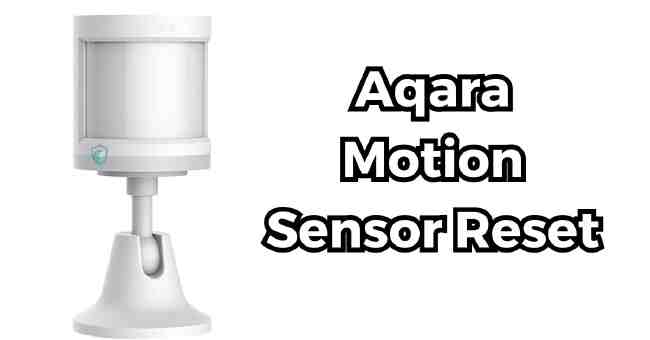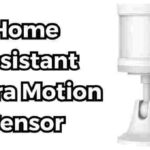Table of Contents
Are you wandering if your aqara motion sensor reset is correct or not? Yes as a home owner and a long-time smart home tinkerer, I’ve had my fair share of frustrations getting finicky devices to play nice.
One ongoing headache was getting my aqara motion sensors working smoothly across moves and WiFi changes.
After the latest connectivity failures left several rooms pitch black after dark, I finally snapped and almost tossed them in the trash!
Thankfully my partner stopped me and gently reminded me I probably just needed to reset the sensors properly.
After taking a deep breath, I promised I would calmly give the reset process one more try before admitting defeat.
Which I successfully did it and resetting this versatile little device is actually simpler than you may realize.
In this comprehensive guide, we’ll cover everything you need to know about resetting your Aqara motion sensor.
Overview of the Aqara Motion Sensor
But first, let’s briefly recap what exactly the Aqara motion sensor is and does.
The aqara motion sensor is a small, battery-powered device produced by Aqara that serves two key functions:
- Motion detection
- Ambient light sensing
It uses a built-in passive infrared (PIR) sensor to reliably detect movement within a range of up to 6 meters. This makes it a useful addition for home automation and security applications.
The Aqara motion sensor communicates via Zigbee and is designed to pair with Aqara’s own line of hubs and gateways. Key features include:
- Wireless and battery-powered
- 6-meter motion detection range
- Adjustable motion sensitivity
- Ambient light sensor
- 110° wide angle lens
- 1-year battery life
Now that we’re familiar with what this handy little device can do, let’s look at why resetting it may sometimes be necessary.
When to Reset Your Aqara Motion Sensor
Resetting the Aqara motion sensor clears out any device-specific settings and restores it to its original factory defaults.
You may want to reset your Aqara motion sensor if you experience any of the following issues:
- It’s no longer responding or exhibits erratic behavior
- You’re unable to pair it with your Aqara hub
- The battery drains faster than expected
- It fails to trigger reliably based on motion detection
- You want to set it up with a new Aqara hub from scratch
Resetting typically resolves problems caused by configuration errors or glitches. It wipes out any settings that could be causing connectivity or performance issues.
So in summary, if your Aqara motion sensor isn’t working right, resetting it is often the first troubleshooting step to take before further diagnosis.
Aqara Motion Sensor Reset: A Step By Step Walkthrough
Resetting the Aqara motion sensor is a simple process that only takes a few seconds. Here is a step-by-step walkthrough:
What You’ll Need
- The Aqara motion sensor
- A pin, paperclip, or toothpick
The Reset Procedure
- Locate the reset button – This tiny button is found on the back or side of the Aqara motion sensor’s housing. It looks like a small pinhole.
- Insert pin – Carefully insert a pin, straightened paperclip, or toothpick into the reset button’s hole.
- Press and hold – Press the reset button down firmly and hold it for 5-10 seconds.
- Wait for indicator light – The motion sensor’s LED indicator will first turn solid blue, then begin rapidly flashing blue after a few seconds. Continue holding until it flashes blue quickly three times.
- Release reset button – Let go of the reset button. The sensor will now restart itself.
- Confirm reset – Wait for about 10 seconds. If the reset succeeded, the motion sensor’s LED will return to slow blinking. The sensor is now reset to factory conditions and ready to be re-paired with your Aqara hub.
And that’s all there is to it! As long as you see the LED blinking slowly after restarting, the Aqara motion sensor reset went through correctly.

Resetting an Aqara motion sensor
Below are some tips to ensure safe and successful resets:
- Don’t use excessive force – gently insert then press the reset pin
- Make sure to hold for at least 5 seconds
- Visually confirm the LED flashing pattern for reset confirmation
- If desired, remove batteries to force a hard reset
Now let’s review some of the most common issues you may encounter after resetting the Aqara motion sensor.
Troubleshooting Problems After Resetting
While most connectivity, responsiveness and battery issues are resolved by a reset, sometimes complications can arise.
Here are some potential post-reset problems and their recommended fixes:
Problem: Sensor fails to connect/pair with the Aqara hub
- Ensure hub and sensor are within 1 – 10 meters for optimal communication
- Upgrade hub and sensor firmware to latest available versions
- Power cycle the hub and sensor
- Remove then re-pair the sensor
Problem: Motion detection remains unresponsive/intermittent
- Adjust placement to eliminate obstructions blocking sensor’s field of view
- Increase motion detection sensitivity setting as needed
- Check battery level – replace batteries if low
- Install latest firmware to enhance motion algorithms
Problem: Incorrect or rapidly draining battery level
- Use properly sized CR2032 lithium coin cell batteries
- Clean battery contacts and compartment for good connections
- Monitor usage patterns – contact support if issue persists
While firmware updates and adjustments can improve things, wireless devices have physical range and environmental limitations.
Getting familiar with optimal aqara motion sensor placement best practices helps minimize situations requiring resets and troubleshooting.
Best Practices for Mounting Your Aqara Motion Sensor
Installing your Aqara motion sensor correctly the first time minimizes connectivity problems and false motion triggers.
Here are some expert recommendations for reliable placement:
- Mount near room entrance for widest coverage
- Position 3 – 6 feet off ground for optimal sensitivity
- Angle slightly downward to match human height
- Avoid facing direct sunlight which can heat PIR sensor
- Keep clear line of sight with no obstructions
- Place within hub’s 10 meter wireless range
- Consider signal boosters if needed for larger spaces
You can fine tune sensitivity and timeout settings later. But following basic placement guidelines improves the probability of issue-free operation.
Using Multiple Aqara Motion Sensors
Some home automation setups call for installing more than one Aqara motion sensor.
Reasons include:
- Monitoring larger spaces
- Eliminating dead zones
- Enhancing redundancy
Utilizing multiple motion sensors requires a bit more planning and configuration. Here are some tips:
- Stagger vertical mounting heights to avoid overlap
- Adjust sensitivities to minimize double triggers
- Consider zoning sensors on different hubs or channels
- Enable indicator lights temporarily when testing coverage
With some experimentation, you can achieve robust motion detection across expansive indoor areas. Just take time tuning settings on each sensor appropriately.
Alternative Motion Sensors
While Aqara motion sensors are versatile and affordable, they aren’t necessarily the best choice for all applications.
Two popular alternatives worth considering include:
1. People counting sensors
Sensors with multiple PIR elements and sophisticated optics can identify motion direction and count people traversing a location.
This enables valuable retail and building occupancy analytics.
Top people counting sensors:
- Xi Sense
- ShopperTrak RCT
- IEE People Counter
2. Pet-immune motion sensors
Standard PIR sensors may excessively trigger with pets at home. Pet-specific versions ignore smaller animals while reliably detecting humans.
Leading pet-immune motion detectors:
- Honeywell Home Pet-Friendly
- malluly Pet Immune PIR
- Ajax MotionProtect Pet
So while Aqara motion sensors deliver excellent basic capabilities, specialty sensors better suit certain professional or residential needs.
Advanced Integrations
A major benefit of the Aqara platform is integration with various smart home ecosystems.
By pairing your Aqara motion sensors with third-party controllers, you gain access to powerful automation rule engines and versatile notifications.
Popular integrations include:
| Platform | Key Features |
|---|---|
| Home Assistant | Open-source, local control; advanced automations |
| Hubitat | Robust integrations; easy rules creation |
| SmartThings | Mass market; Works with Alexa / Google Assistant ecosystems |
Complex integrations do introduce more points of potential failure. But comprehensive platforms greatly extend what’s possible well beyond standalone operation.
Resetting sensors can help stabilize flaky behavior when operating in these interconnected environments.
Best Practices for Aqara Motion Sensor Maintenance
Like any hardware device, periodic maintenance helps keep your Aqara motion sensor running optimally. Follow these reliability-boosting tips:
1. Update firmware frequently
Firmware updates improve connectivity, motion detection, and battery usage. Install updates for the sensor and paired hubs promptly.
2. Replace batteries annually
While battery life up to 2 years is possible, yearly battery swaps ensure peak detection performance.
3. Keep contacts clean
Use isopropyl alcohol to gently clean battery contacts and compartment yearly to maintain a robust power connection.
4. Verify placement angles
As you rearrange furniture, make sure motion sensors haven’t been inadvertently shifted out of alignment.
Staying on top of these basics will maximize uptime and minimize unexpected issues.
Frequently Asked Questions
What Causes Aqara Sensors To Stop Working Reliably?
Common factors include depleted batteries, physical alignment changes, distance/interference with hubs, firmware bugs, wireless interference from other smart home devices, limited range, and simple hardware failure after extended usage.
Do I Lose All My Settings If I Factory Reset?
No, your Aqara app configuration persists across resets of the motion sensor itself. However, you will have to re-pair the sensor to your hub. Resetting is not a full “factory” reset despite the naming.
My Aqara Sensor Won’t Connect After A Reset – How Can I Fix This?
If an Aqara sensor fails to pair with the hub after a reset, power cycle the hub, ensure adequate hub proximity, eliminate wireless interference from other smart devices, then attempt paring again. Still not working? Contact Aqara support.
Why Does My Aqara Motion Sensor Trigger When There’s No Movement?
False triggers typically result from sensitivity set too high, sunlight/heat directly hitting the PIR sensor, small pets, air ducts blowing on sensor, vibration from closing doors, or reflective surfaces like mirrors in the field of view.
How Long Do Aqara Motion Sensor Batteries Actually Last?
Average CR2032 coin cell battery life is 1 – 2 years depending on activity levels.
Frequent motion events, extreme hot/cold climates, and peaks in wireless transmission reduce usable lifespan.
Stick to name brand batteries from the likes of Panasonic or Energizer for longest duration.
How Do I Pair My Aqara Motion Sensor?
Pairing an Aqara motion sensor to your hub is thankfully quick and straightforward. Just follow these steps:
- Bring the Aqara motion sensor within 1-10 meters of your hub for the pairing process. Closer proximity helps ensure a strong initial connection.
- Open the Aqara Home app and navigate to the “Add Device” section under Hub Settings.
- Insert the batteries into your Aqara motion sensor. The LED will first display solid blue then begin slowly blinking when ready for pairing.
- The hub will automatically detect the motion sensor and ask you to confirm adding it. Hit Confirm once detected and it will immediately pair.
Once successfully paired, you can rename the device, assign it to rooms, and configure options like motion sensitivity and LED indicator preferences.
Enjoy automated notifications and triggers based on the motion detection events!
If the pairing fails or the sensor is not detected, reset both the hub and sensor then carefully retry the process. Support is also available via the Aqara app if issues persist.
How Do I Reset My Zigbee Motion Sensor?
If your Zigbee-based motion sensor like Aqara is acting unreliably, resetting it often helps resolve connectivity and performance problems.
Resetting typically involves pressing and holding a tiny pinhole button on the device for 5-10 seconds until an LED flashes a pattern, indicating a restart.
Always check your specific brand’s documentation to confirm the reset procedure.
For Aqara motion sensors, the reset button is on the back near the bottom. Press and hold it with a pin until the LED blinks blue quickly three times.
After resetting, you’ll have to re-pair the Zigbee motion sensor to your smart home hub before it can resume automated functionality. But resetting often mitigates sensor issues.
How Do I Reconnect My Aqara Temperature Sensor?
Has your previously reliable Aqara temperature sensor disconnected from the hub and Aqara app? Annoying but easily amended.
First, perform a simple power cycle by removing the Aqara sensor’s battery, waiting 10 seconds, then reinserting it.
This resets the wireless connection often letting it automatically reconnect.
If that fails, try manually removing then re-pairing it within the Aqara app. Navigate to Hub Settings > Device Management > Temperature Sensor > Unpair then walk through repairing.
Still not reconnected? The nuclear option is performing a hardware reset on the sensor using the tiny pinhole button.
Hold for 3+ seconds until flashing then reboot. Removed sensors must be repaired.
Assuming your hub is online and in range, those steps should get your Aqara temperature sensor back up and running wirelessly in just a few minutes.
What Is The Detection Interval Of Aqara Motion Sensor?
The Aqara motion sensor detection interval determines how soon after initial motion the sensor resets to allow detecting additional movement. This affects responsiveness for lighting automation and security notifications.
Intervals are set via the device’s sensitivity settings:
- Low Sensitivity: Interval 15 seconds
- Medium Sensitivity: Interval 6 seconds
- High Sensitivity: Interval 2 seconds
So higher sensitivity enables faster recurring detection following previous motion events.
Note that after detecting motion, there is an additional inactivity period before notifications are sent or rules are triggered. This prevents excessive updates when continuously occupied.
Finding the right balance between responsiveness and stability is key for your use case with some fine tuning likely required. Start conservatively then adjust until satisfied.
Conclusion
And after plenty of trial and error, I’m thrilled to have reliable motion automation again!
The key is following certain steps when resetting these temperamental sensors. Remember to always power cycle your hub first, hold the reset buttons for a full 8-10 seconds, visually confirm the LED reset patterns, and manually re-pair after rebooting.
Embrace these lessons to minimize throwing perfectly functional aqara motion sensors against the wall during your smart home journey!
Going forward, I now know the proper reset method can resolve most issues. But if problems ever persist, for the sake of your sanity reach out to Aqara’s surprisingly helpful support staff.




